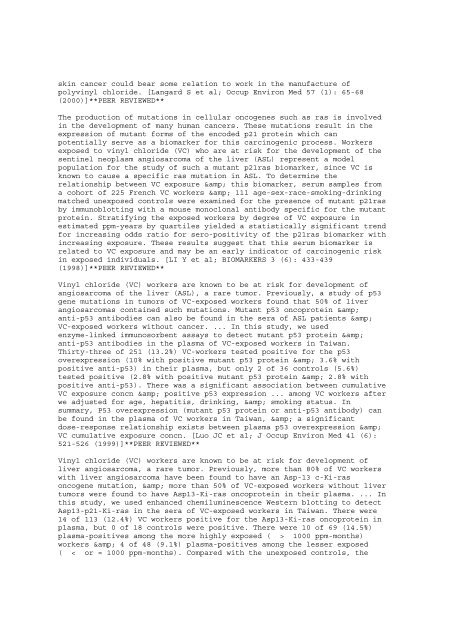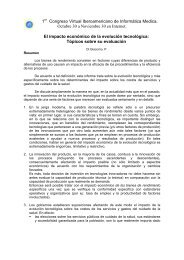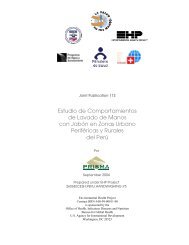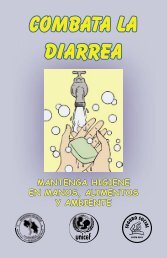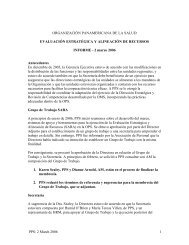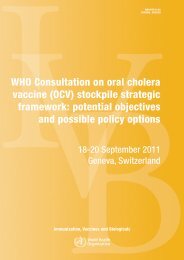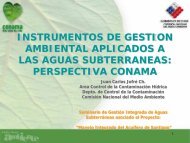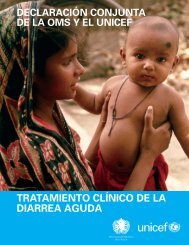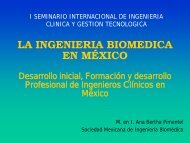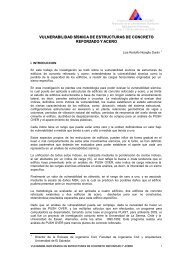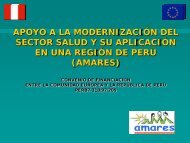a database of the National Library of M
a database of the National Library of M
a database of the National Library of M
Create successful ePaper yourself
Turn your PDF publications into a flip-book with our unique Google optimized e-Paper software.
skin cancer could bear some relation to work in <strong>the</strong> manufacture <strong>of</strong>polyvinyl chloride. [Langard S et al; Occup Environ Med 57 (1): 65-68(2000)]**PEER REVIEWED**The production <strong>of</strong> mutations in cellular oncogenes such as ras is involvedin <strong>the</strong> development <strong>of</strong> many human cancers. These mutations result in <strong>the</strong>expression <strong>of</strong> mutant forms <strong>of</strong> <strong>the</strong> encoded p21 protein which canpotentially serve as a biomarker for this carcinogenic process. Workersexposed to vinyl chloride (VC) who are at risk for <strong>the</strong> development <strong>of</strong> <strong>the</strong>sentinel neoplasm angiosarcoma <strong>of</strong> <strong>the</strong> liver (ASL) represent a modelpopulation for <strong>the</strong> study <strong>of</strong> such a mutant p21ras biomarker, since VC isknown to cause a specific ras mutation in ASL. To determine <strong>the</strong>relationship between VC exposure & this biomarker, serum samples froma cohort <strong>of</strong> 225 French VC workers & 111 age-sex-race-smoking-drinkingmatched unexposed controls were examined for <strong>the</strong> presence <strong>of</strong> mutant p21rasby immunoblotting with a mouse monoclonal antibody specific for <strong>the</strong> mutantprotein. Stratifying <strong>the</strong> exposed workers by degree <strong>of</strong> VC exposure inestimated ppm-years by quartiles yielded a statistically significant trendfor increasing odds ratio for sero-positivity <strong>of</strong> <strong>the</strong> p21ras biomarker withincreasing exposure. These results suggest that this serum biomarker isrelated to VC exposure and may be an early indicator <strong>of</strong> carcinogenic riskin exposed individuals. [LI Y et al; BIOMARKERS 3 (6): 433-439(1998)]**PEER REVIEWED**Vinyl chloride (VC) workers are known to be at risk for development <strong>of</strong>angiosarcoma <strong>of</strong> <strong>the</strong> liver (ASL), a rare tumor. Previously, a study <strong>of</strong> p53gene mutations in tumors <strong>of</strong> VC-exposed workers found that 50% <strong>of</strong> liverangiosarcomas contained such mutations. Mutant p53 oncoprotein &anti-p53 antibodies can also be found in <strong>the</strong> sera <strong>of</strong> ASL patients &VC-exposed workers without cancer. ... In this study, we usedenzyme-linked immunosorbent assays to detect mutant p53 protein &anti-p53 antibodies in <strong>the</strong> plasma <strong>of</strong> VC-exposed workers in Taiwan.Thirty-three <strong>of</strong> 251 (13.2%) VC-workers tested positive for <strong>the</strong> p53overexpression (10% with positive mutant p53 protein & 3.6% withpositive anti-p53) in <strong>the</strong>ir plasma, but only 2 <strong>of</strong> 36 controls (5.6%)tested positive (2.8% with positive mutant p53 protein & 2.8% withpositive anti-p53). There was a significant association between cumulativeVC exposure concn & positive p53 expression ... among VC workers afterwe adjusted for age, hepatitis, drinking, & smoking status. Insummary, P53 overexpression (mutant p53 protein or anti-p53 antibody) canbe found in <strong>the</strong> plasma <strong>of</strong> VC workers in Taiwan, & a significantdose-response relationship exists between plasma p53 overexpression &VC cumulative exposure concn. [Luo JC et al; J Occup Environ Med 41 (6):521-526 (1999)]**PEER REVIEWED**Vinyl chloride (VC) workers are known to be at risk for development <strong>of</strong>liver angiosarcoma, a rare tumor. Previously, more than 80% <strong>of</strong> VC workerswith liver angiosarcoma have been found to have an Asp-13 c-Ki-rasoncogene mutation, & more than 50% <strong>of</strong> VC-exposed workers without livertumors were found to have Asp13-Ki-ras oncoprotein in <strong>the</strong>ir plasma. ... Inthis study, we used enhanced chemiluminescence Western blotting to detectAsp13-p21-Ki-ras in <strong>the</strong> sera <strong>of</strong> VC-exposed workers in Taiwan. There were14 <strong>of</strong> 113 (12.4%) VC workers positive for <strong>the</strong> Asp13-Ki-ras oncoprotein inplasma, but 0 <strong>of</strong> 18 controls were positive. There were 10 <strong>of</strong> 69 (14.5%)plasma-positives among <strong>the</strong> more highly exposed ( > 1000 ppm-months)workers & 4 <strong>of</strong> 48 (9.1%) plasma-positives among <strong>the</strong> lesser exposed( < or = 1000 ppm-months). Compared with <strong>the</strong> unexposed controls, <strong>the</strong>


